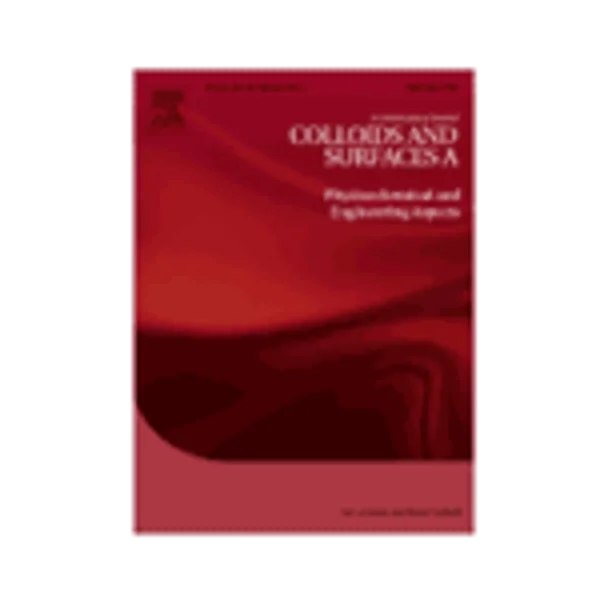-
nonionic reverse micelle formulation and their microstructure transformations in an aromatic solvent ethylbenzene
جزئیات بیشتر مقاله- تاریخ ارائه: 1392/07/24
- تاریخ انتشار در تی پی بین: 1392/07/24
- تعداد بازدید: 1251
- تعداد پرسش و پاسخ ها: 0
- شماره تماس دبیرخانه رویداد: -
formation of reverse micelles at room temperature generally requires inclusion of water or other polar molecules in a mixture of long chain ionic surfactant and an organic solvent. in this paper, we report the formulation of nonionic reverse micelles at room temperature in an aromatic solvent, ethylbenzene using short-chain glycerol-based surfactants, and investigated the microstructure transformations induced by surfactant chain length, concentration, and temperature using saxs and rheometry. we have also determined water solubility in reverse micelle and investigated water induced microstructure transitions. we found that a short chain nonionic surfactant, diglycerol monocaprate (c10g2), spontaneously self-assembles into an ellipsoidal prolate type micelle. increasing surfactant chain induces a prolate-to-globular type transition forming globular micelles in diglycerol monomyristate (c14g2), which is expected to be caused by an increase in the lipophilicity of the surfactant. increases in surfactant concentration favored one-dimensional micellar growth; the micellar size increases ca. 4.5–7.25 nm upon increase in the surfactant concentration from 3 to 20% while the cross-sectional radius maintained almost constant ca. 1.10 nm in the diglycerol monolaurate (c12g2) system. in contrast to the nonionic micelles in aqueous systems, reverse micelles get smaller with increasing temperature, which is similar to a rod-to-sphere type transition. addition of trace water promotes a significant micellar growth; both the maximum dimension and radius of micelles increases and the size of the water-incorporated micelles was approximately three times greater than the micelles in the absence of water. microstructure transitions revealed by saxs are supported by rheological measurements; the relative zero-shear viscosity decreased with increase in the chain length of surfactant. on the other hand, relative viscosity increased nearly one order of magnitude upon increase in surfactant concentration from 3 to 20%.
مقالات جدیدترین رویدادها
-
استفاده از تحلیل اهمیت-عملکرد در ارائه الگوی مدیریت خلاقیت سازمانی و ارائه راهکار جهت بهبود
-
بررسی تاثیر ارزش وجوه نقد مازاد بر ساختار سرمایه شرکت های پذیرفته شده در بورس اوراق بهادار تهران
-
بررسی تأثیر سطح افشای ریسک بر قرارداد بدهی شرکت های پذیرفته شده در بورس اوراق بهادار تهران
-
بررسی تأثیر رتبه بندی اعتباری مبتنی بر مدل امتیاز بازار نوظهور بر نقد شوندگی سهام با تأکید بر خصوصی سازی شرکت ها
-
تأثیر آمیخته بازاریابی پوشاک ایرانی بر تصویر ذهنی مشتری پوشاک ایرانی (هاکوپیان)
-
تغییرات اقلیمی و پیامد های آن برمنابع محیط زیستی کشور و تاثیر گذاری آن بر شرایط زندگی
-
بررسی نقش ادبیات (داستان و شعر) در تثبیت هویت کودکان ایرانی
-
اثربخشی آموزش مداخله های تربیتی کلاس محور (برای معلمان) بر خودکارآمدی تحصیلی دانش آموزان
-
بررسی تناسبات حمام های ایرانی با رویکرد اقلیمی نمونه موردی حمام نوبر تبریز
-
بررسی ضریب رفتار و پارامترهای موثر بر آن در سیستم های دیوار برشی فولادی با مقاومت تسلیم پایین
مقالات جدیدترین ژورنال ها
-
مدیریت و بررسی افسردگی دانش آموزان دختر مقطع متوسطه دوم در دروان کرونا در شهرستان دزفول
-
مدیریت و بررسی خرد سیاسی در اندیشه ی فردوسی در ادب ایران
-
واکاوی و مدیریت توصیفی قلمدان(جاکلیدی)ضریح در موزه آستان قدس رضوی
-
بررسی تاثیر خلاقیت، دانش و انگیزه کارکنان بر پیشنهادات نوآورانه کارکنان ( مورد مطالعه: هتل های 3 و 4 ستاره استان کرمان)
-
بررسی تاثیر کیفیت سیستم های اطلاعاتی بر تصمیم گیری موفق در شرکتهای تولیدی استان اصفهان (مورد مطالعه: مدیران شرکتهای تولیدی استان اصفهان)
-
تحلیل اخلاقی و کلامی داستان حضرت موسی (علیه السلام) و حضرت خضر نبی (علیه السلام)
-
بررسی تاثیر قابلیت مقایسه صورت های مالی بر نوسانات نامتعارف بازده سهام
-
بررسی تاثیر وابستگی به گروه تجاری بر انتخاب حسابرس
-
تاثیر تنوع جنسیتی بر رفتار نامتقارن هزینه های عمومی اداری و فروش
-
واکاوی مبانی فقهی ممنوعیت تخریب محیط زیست




سوال خود را در مورد این مقاله مطرح نمایید :